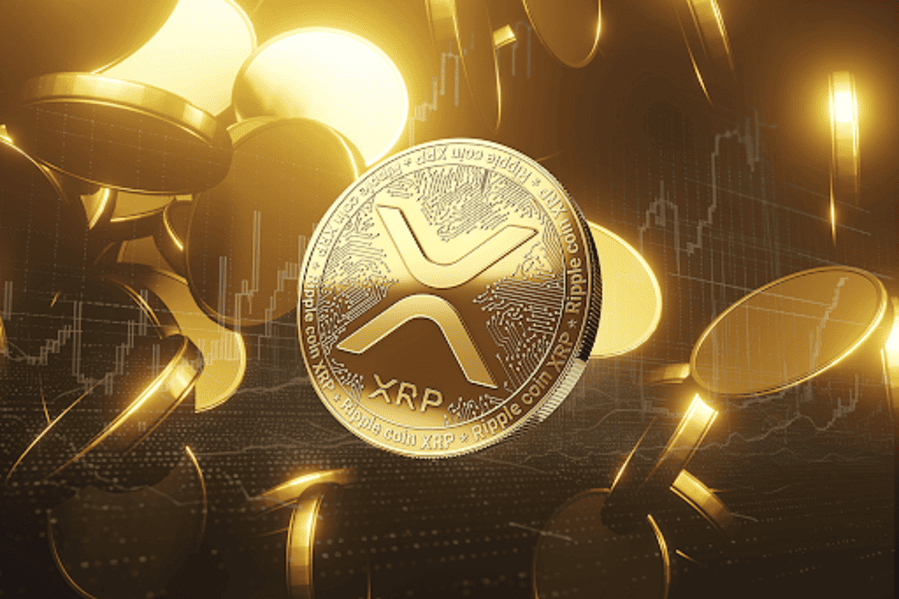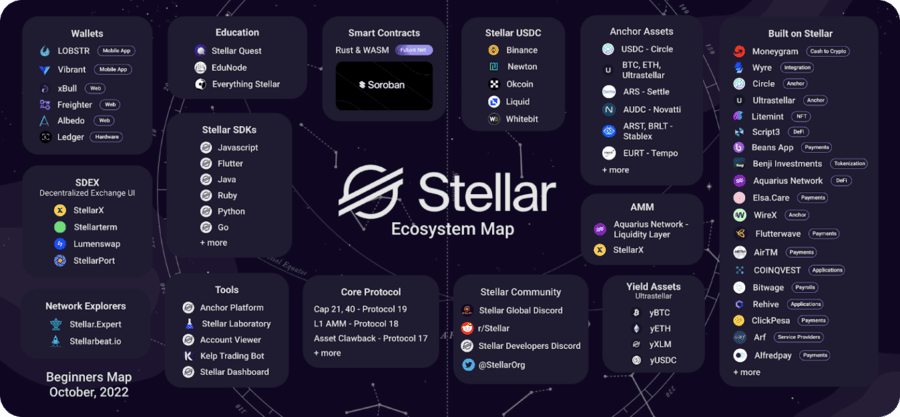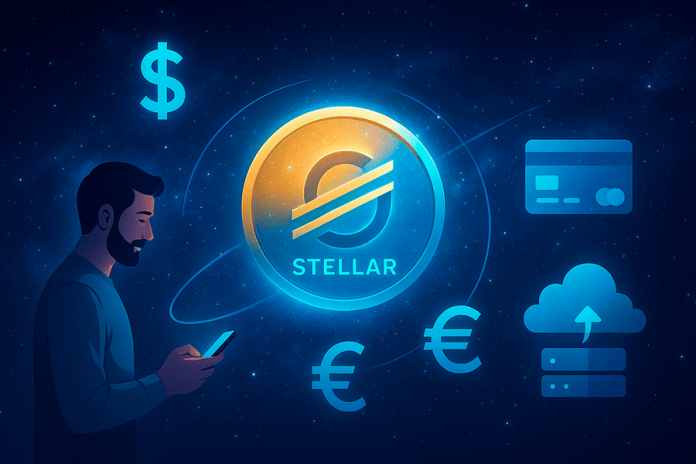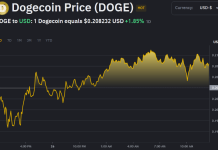International money transfers still feel like they belong to another era – delayed, inconvenient, and often surprisingly expensive. Stellar (XLM) doesn’t promise to change the world overnight, but it does something more useful: it cuts through the mess and shows how global transactions can be fast, cheap, and smooth without layers of bureaucracy.
This isn’t just a coin on a chart or a name in a whitepaper. Stellar is a working system, built with one goal – to make cross-border financial operations as frictionless as sending a message in a chat app. One second – and your transaction is confirmed. Fees? Less than the price of a chewing gum. No one stands between you and the recipient – no banks, no clearing houses, no middle steps.
Behind Stellar is a team that’s already working with banks, supporting nonprofits, and building real infrastructure for a financial future that actually works for everyone – not just institutions. In this guide, you’ll get a clear understanding of what Stellar is, what XLM is for, and how to get started – even if you’re new to crypto and not sure where to begin.
Key Facts About Stellar:
- Stellar is a platform designed for lightning-fast international money transfers.
- XLM is the coin used to pay transaction fees within the network.
- Most transactions take just 3–5 seconds to complete.
- Average fee per transaction is less than $0.01.
- No intermediaries – transactions happen directly between users.
- Stellar actively partners with large banks and financial firms.
- It supports nonprofit and humanitarian projects.
- As of 2025, the platform continues to grow and evolve.
What Is Stellar (XLM)?
Stellar is a decentralized financial system designed to make exchanging money across borders both accessible and efficient. It wasn’t built for future speculation – it was built to work now, offering people a reliable way to transfer value without relying on outdated infrastructure or legacy banks.
The backbone of Stellar is a custom consensus model that doesn’t depend on resource-heavy mining or proof-of-work schemes. Instead, the network validates transactions through a lightweight agreement process that allows operations to be confirmed in just seconds – even when the system is under high demand. This lets Stellar avoid the lags and fees still common in both traditional finance and earlier blockchain networks.
At the center of this network is the digital asset XLM, also known as Stellar Lumens. It plays two essential roles: first, it covers tiny transaction costs across the network, and second, it acts as a middle-layer currency that enables smooth conversions between different forms of value – whether you’re exchanging dollars for euros, tokens, or something else entirely.
What Makes Stellar Lumens Different
XLM isn’t designed to sit idly in a wallet hoping for a price spike. It was made to be used – and it shows. Here’s what makes Stellar’s native coin stand out from the rest:
- Transactions are confirmed almost instantly – typically within five seconds, no matter where you or the recipient are located.
- Sending money costs practically nothing – usually less than a penny.
- No need for banks or clearinghouses – transfers happen directly from one person to another.
- The network can handle thousands of transactions per second, making it scalable for both personal and enterprise use.
- Users can send and receive fiat-backed assets like USD and EUR, not just crypto – making it useful even outside the blockchain ecosystem.
- Stellar has built partnerships with major institutions, a sign of credibility and long-term potential.
- The low cost of transactions makes the platform ideal for nonprofits and humanitarian efforts – more funds go where they’re needed.
- It’s an open-source project, with code and decisions made in the public eye – which builds transparency and trust.
The idea behind Stellar is refreshingly practical: to help money flow faster, more affordably, and with fewer complications – regardless of what form that money takes.
What Are Bridge Assets in the Stellar Network?
Bridge assets are special-purpose tokens inside the Stellar system. Each one is tied to the value of a real-world asset – whether that’s fiat currency like the US dollar or another crypto. Their role? To help different currencies connect without friction.
Instead of using a traditional currency exchange, Stellar allows users to send one type of asset and have the recipient get another – all in a single, fluid transaction. The bridge asset does the behind-the-scenes work of translating one value into another, which makes transfers across currencies much faster and less expensive.
This is one of the things that sets Stellar apart: it makes dealing with multiple currencies feel as easy as sending just one – no waiting, no unnecessary conversions, no outside platforms.
How to Store XLM
There are several ways to store your XLM, depending on how often you need access and how much security you want.
If you’re looking for something simple and easy to manage from your phone or browser, software wallets like StellarTerm or StellarWallet are convenient options. They give you full access to your coins while keeping things user-friendly.
But if long-term safety is your goal – for example, if you’re holding a significant amount or don’t plan to use it daily – a hardware wallet like Ledger or Trezor is the better pick. These devices store your keys offline, protecting them from hacks or malware.
Whatever option you go with, the main point is this: XLM is your digital asset, and protecting it is up to you.
Where to Buy Stellar Lumens (XLM)
There are three common ways to get your hands on XLM: through exchanges, peer-to-peer (P2P) platforms, or online currency exchangers. Each one works – it just depends on what fits you best.
Exchanges
Exchanges are the most straightforward and widely used way to buy XLM. You register an account, fund it with fiat money or another cryptocurrency, and make the trade.
- Binance – One of the largest exchanges in the world, Binance supports XLM trading with a wide range of fiat pairs. Low fees and solid trading tools make it a favorite.
- Coinbase – Great for newcomers. It offers an intuitive interface and lets you buy XLM directly using a debit card or bank transfer.
- Kraken – Known for tight security and reliability, Kraken supports XLM along with dozens of other coins.
If you want a stable, trusted option – and don’t mind verifying your identity – exchanges are your go-to.
Peer-to-Peer (P2P) Platforms
P2P platforms let you buy XLM directly from other users, with no middleman in the process. You agree on the price and payment method, then settle the deal.
- LocalBitcoins – Though it focuses mostly on Bitcoin, you can occasionally find users offering to trade XLM.
- Paxful – A more versatile P2P platform that supports many cryptos. It’s possible to find listings for XLM, especially if you’re using flexible payment options.
These platforms are ideal if you want to keep control over the terms of your trade or avoid standard exchange procedures.
Online Exchangers
Online currency exchangers are quick and simple. You pick a payment method – like PayPal, bank transfer, or even a mobile wallet – and they deliver the XLM to your crypto address.
The trade-off? Their convenience usually comes with slightly higher fees. Still, if you’re in a hurry or want to skip the registration process, they’re a solid option.
Buying Stellar Lumens with a Bank Card
If you want to buy XLM using your debit or credit card, the process is pretty painless. Here’s what to do:
- Choose an exchange that accepts card payments – Binance and Coinbase are both solid picks.
- Sign up and verify your identity. Most platforms will ask for basic documents to meet legal requirements.
- Link your card and deposit funds into your account.
- Select XLM from the available cryptocurrencies, enter the amount, and complete the purchase.
The entire process takes just a few minutes, even if it’s your first time. Just don’t forget to check what kind of fee the exchange charges for card transactions – they can vary depending on the provider.
How to Save on Fees When Buying XLM
If you’re looking to stretch your funds and avoid unnecessary fees while purchasing XLM, there are a few smart tactics worth knowing.
- Use P2P services on major exchanges. Platforms like Binance often have built-in peer-to-peer sections where you can buy directly from other users – usually with no exchange fees at all.
- Compare exchanger offers before committing. Some online exchangers charge noticeably less than others, so taking a moment to shop around can lead to better rates.
- Review the fee structures of each platform. Every exchange has its own rules when it comes to deposits, withdrawals, and trades. Binance, for instance, is known for its relatively low overall costs, which makes it a favorite for cost-conscious users.
With just a bit of research and attention, you can cut your expenses and walk away with more XLM in your wallet.
Stellar vs Ripple – What Sets Them Apart?
At first glance, Stellar and Ripple may seem like siblings – both were created to improve cross-border transactions and modernize global money flows. But the differences between them run deep, especially in terms of purpose and technical design.
- Technology – Stellar uses the Stellar Consensus Protocol (SCP), which prioritizes fast, low-cost transactions. Ripple, meanwhile, operates on RippleNet, which is tailored more to banking infrastructure.
- Target audience – Stellar is open to everyone: individuals, startups, nonprofits. Ripple, on the other hand, is aimed squarely at large banks and financial corporations.
- Cost and speed – In general, Stellar edges out Ripple when it comes to everyday usage. It’s faster and cheaper, making it an ideal tool for smaller-scale users and small businesses.
While both aim to modernize global payments, they follow very different paths – and serve different types of users in the process.

Real-World Applications of Stellar Lumens
Stellar isn’t just an experimental technology – it’s already out there solving practical problems. Here’s where it shines most:
- Cross-border payments – Whether you’re a freelancer working with international clients or someone sending money to family abroad, Stellar provides a fast, low-cost way to move funds.
- Financial system integration – Traditional banks and fintech companies are beginning to use Stellar to connect their systems to the blockchain world – often with impressive results.
- Support for nonprofits – Because Stellar is both fast and inexpensive, it’s perfect for charitable organizations that need to send aid without losing large chunks of their donations to fees.
These examples show that Stellar isn’t just a platform for speculation – it’s a working, dependable financial rail with global reach.
The Stellar Ecosystem – Beyond a Simple Network
Stellar isn’t just a single tool or app – it’s become an ecosystem made up of people and projects working in sync across finance and technology.
- Companies like IBM and MoneyGram have adopted Stellar to improve how they handle international transfers and currency swaps.
- Wallet services and payment platforms are being built around Stellar’s infrastructure, giving users intuitive ways to send and receive assets.
- Developers are creating everything from decentralized markets to community banking tools using Stellar as a foundation.
- NGOs and relief organizations use Stellar to distribute aid faster and more transparently than traditional systems allow.
- And the Stellar Development Foundation (SDF) continues to guide the growth of the network – funding new projects and keeping things moving forward.
With every new participant, Stellar becomes more capable, more trusted, and more ready to serve people on a global scale.

Looking Ahead
The future of Stellar isn’t about buzzwords or price predictions – it’s about solving everyday problems. Whether it’s streamlining cross-border payments, connecting underbanked regions, or offering nonprofits a better way to move funds, Stellar has already proven itself useful.
What lies ahead is broader adoption, more integrations with traditional finance, and continued work toward a more open financial world – one where anyone, anywhere, can send and receive money in seconds, not days.
Investing in Stellar (XLM): What You Should Know
As with any digital asset, putting money into XLM comes with both potential rewards and notable risks. Here are the main points to keep in mind:
- Volatility – Like most cryptocurrencies, the value of XLM can swing sharply over short periods. That makes it both a high-risk and high-reward investment.
- Regulatory uncertainty – The legal status of crypto varies across countries and is still evolving. A sudden change in policy could affect Stellar’s accessibility in some regions.
- Market competition – Stellar isn’t alone. Other major players – including Ripple – are operating in the same space and often appeal to similar partners.
That said, there are also clear strengths supporting Stellar’s long-term viability:
- Positive legal trends – Ripple’s partial court victory against the SEC, where XRP was ruled not to be a security when sold on exchanges, may help projects like Stellar avoid overregulation.
- Strong partnerships – Collaborations with IBM, MoneyGram, and others have brought Stellar’s technology into real-world use, making blockchain-based payments more accessible for millions.
- Technological reliability – Stellar’s track record for uptime, speed, and cost efficiency remains one of the best in the industry.
All things considered, Stellar continues to look like one of the most grounded and forward-looking blockchain projects in the payments sector.
Final Thoughts
Stellar (XLM) isn’t trying to be the flashiest coin in the crypto universe – and that’s exactly its strength. It’s built for people who want their money to move fast, reach far, and get where it’s going without losing half of it to fees or delays.
Whether you’re an everyday user sending remittances, a nonprofit delivering global aid, or a business building tools on blockchain, Stellar offers a simple, effective, and secure way to make transactions work the way they should – no matter where you are in the world.
The photos in the article are provided by the company(s) mentioned in the article and used with permission.
Disclaimer: This article contains sponsored marketing content. It is intended for promotional purposes and should not be considered as an endorsement or recommendation by our website. Readers are encouraged to conduct their own research and exercise their own judgment before making any decisions based on the information provided in this article.





































